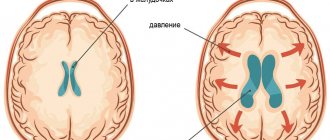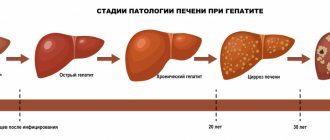Sign up
Price
Our doctors
- How do you get Hepatitis A?
- What are the symptoms of Hepatitis A?
- How is hepatitis A transmitted?
- Stages of Botkin's disease
- How to treat hepatitis A in a child
- How to treat hepatitis A in an adult
- How to treat chronic hepatitis A
- How to determine the presence of Botkin's disease
- What can you eat if you have hepatitis A?
- How to avoid getting hepatitis A
- Who to contact with hepatitis A
Hepatitis A or Botkin's disease is a medical term for a condition of acute damage to liver cells. The disease is caused by the virus of the same name (HAV) and is considered relatively safe for human life (compared to other types of hepatitis). The disease does not enter a protracted (chronic) stage; treatment of hepatitis A is quite productive, which leads to stable remission and subsequent complete cure.
TREATMENT OF HEPATITIS A IS AVAILABLE IN BRANCHES:
Treatment of hepatitis A in the Primorsky region
Address: St. Petersburg , Primorsky district, st. Repisheva, 13
Treatment of hepatitis A in the Petrograd region
Address: St. Petersburg , Petrogradsky district, st. Lenina, 5
Treatment of hepatitis A in Vsevolozhsk
Address: Vsevolozhsk , Oktyabrsky Prospekt, 96 A
The main symptom of hepatitis A is yellowing of the skin, which is why the disease is popularly called “jaundice.”
Causes of hepatitis A (Botkin's disease)
“Disease of dirty hands” is exactly the definition given by doctors around the world to this condition. Hepatitis A occurs only through contact with a sick person. The virus excreted in feces during the incubation period of the disease is most active. Hepatitis of the icteric or erased form is often completely asymptomatic; the person does not understand that he is sick, being a source of infection for those around him and random people who come into contact with the patient’s waste products. People do not see a doctor for a long time, which aggravates the course of the disease and complicates the treatment of hepatitis A. Mortality from this condition is observed in only 0.5% of situations.
In 40% of cases, the hepatitis A virus causes the development of other hepatitis.
Preventive recommendations
To avoid Botkin's disease or reduce the risk of developing it, it is recommended to adhere to the following tips:
- wash your hands before eating and after visiting public places;
- observe precautions when living with a patient with hepatitis A in the same area;
- drink water only from proven sources;
- have one sexual partner or use barrier protection (condoms) during casual intimacy;
- follow food preparation technology without reducing the time of exposure to high temperatures;
Hepatitis A is a disease with a favorable prognosis, but treatment should not be neglected. Thanks to timely diagnosis and therapeutic measures, it is possible to reduce the area of liver damage and quickly restore its functioning.
Symptoms of Hepatitis A (Botkin's Disease)
You can find out about the presence of hepatitis in the body by the following signs:
- a sharp increase in body temperature (38.5-39°C);
- the appearance of signs of intoxication of the body, such as dizziness, nausea, severe weakness, a feeling of aching in the joints, bones, muscles;
- atypical belching, vomiting for no reason;
- feeling of heaviness under the ribs on the right side;
- diarrhea or constipation;
- pain in the abdominal area;
- loss of appetite;
- general malaise and severe weakness;
- Sometimes there is a sore throat and pain when swallowing.
Together, these symptoms indicate hepatitis disease and require immediate initiation of therapy. Treatment of hepatitis A often begins only after the onset of severe jaundice: yellowing of the sclera and skin, darkening of urine and sharp lightening of stool - usually this occurs on days 3-5 of the disease.
The incubation period for hepatitis ranges from 14 to 42 days.
How to protect yourself from hepatitis B?
The only means of protection is vaccination against hepatitis B, which is currently administered to all newborn children and adolescents. Adults with risk factors for infection should also be vaccinated. The hepatitis B vaccine is one of the safest vaccines in the world. Three-time administration of the vaccine according to a special scheme leads to the formation of specific antibodies that prevent the development of hepatitis B disease in 98% of those vaccinated. Immunity lasts for at least 8-10 years, but often remains for life.
Routes of transmission of hepatitis A (Botkin's disease)
The main routes of transmission of hepatitis A are:
- water - when sewage gets into the water supply network or when swimming in lakes and reservoirs in the warm season;
- food – poorly washed fruits and vegetables, dirty hands;
- household items - toys, dishes, linen, etc.;
- sexually - infection with hepatitis A is transmitted in this way extremely rarely, mainly among homosexuals;
- through blood - also in rare cases (situations were noticed among drug addicts and in recipients who received blood from a carrier of the hepatitis virus).
This type of hepatitis A often occurs in the summer, when it is warm outside, people begin to eat more food outside the home and appear in public places more often. Children who are not familiar with the rules of personal hygiene suffer more from the disease. A huge percentage of patients are observed in underdeveloped countries of the world, where there are significant environmental problems.
Causes
The disease is of infectious origin. It is caused by a virus that, upon entering the body, affects the liver and leads to the death of hepatocytes. Infection can occur:
while swimming in a polluted body of water and swallowing water;- when consuming contaminated products;
- when using an infected needle;
- during intimacy (more typical for homosexuals);
- when drinking poorly purified water;
- when using household items (dishes, towels) together with the patient. To avoid the spread of infection, the latter must be isolated throughout the jaundice. The dangerous period is the end of the incubation period and the height of pathology;
- when consuming infected marine life (shellfish).
The risk of infection increases when traveling to hot countries, as well as when hygiene rules are not followed.
The virus is an RNA pathogen and has good resistance to unfavorable conditions.
Stages of Botkin's disease
Hepatitis A in stage 1 is invisible, since the patient does not even understand that he is sick. The duration of the period is 14-42 days (depending on the person’s immunity and aggravating factors, the average is 28 days). At this time, treatment for hepatitis A is not carried out, since the disease is asymptomatic and does not manifest itself in any way.
At the next stage, which lasts from the moment the disease is detected to 54 days, the first symptoms appear:
- general weakness, deterioration of health, fatigue;
- pain in muscles and joints;
- pain in the right side, a feeling of tightness under the ribs in the liver area;
- liver enlargement;
- loss of appetite, dyspeptic disorders;
- itching of the skin.
In children, all these symptoms may be mild or completely absent.
At the third stage, hepatitis is complicated by infection with the HAV virus with characteristic symptoms:
- yellowing of the skin and sclera (“jaundice”);
- discoloration of stool;
- brown urine.
This stage occurs from days 54 to 90. At the first sign of yellowing, treatment for hepatitis A should be started immediately.
Complications
Hepatitis A rarely causes complications; usually the disease ends in complete recovery. The most severe complication of Botkin's disease is liver failure. After recovery from hepatitis A, strong immunity usually remains and re-infection is not possible. However, if treatment is not completed and complete recovery does not occur, a second wave of the disease may occur - a relapse. This happens in 15% of people with Botkin's disease and can occur repeatedly.
Liver failure is a rare and potentially life-threatening complication of hepatitis in which the liver may stop functioning normally. The following groups of people are usually affected by it:
- people with weakened immune systems (as a result of a chronic disease such as diabetes or a side effect of certain treatments such as chemotherapy).
- people with existing liver disease such as cirrhosis or hepatitis C (a more severe type of hepatitis);
Some symptoms of liver failure are similar to those of hepatitis A and include jaundice, nausea and vomiting.
Treatment of hepatitis A (Botkin's disease) in children
Therapeutic activities for children of different ages are carried out taking into account the stage and neglect of the process. Usually it is necessary to place the child in a hospital, where hepatitis A will be treated in accordance with the norms and rules of SanPiN. This prevents the spread of infection and cuts off routes of infection. Each child is housed separately in the hospital to prevent cross-transmission of the virus to each other. This greatly facilitates the process of treating hepatitis A in children, especially younger ones.
Therapy includes strict bed rest during the acute period. This treatment of Botkin's disease lasts until the color of urine normalizes and laboratory blood tests improve.
To alleviate the condition of intoxication, treatment of viral hepatitis A with detoxification agents is prescribed: saline solution and glucose solution intravenously. Patients take sorbents internally: activated carbon, Enterosgel, Filtrum, etc.
Hormonal therapy is not usually used in pediatric therapy, but is relevant for malignant progression and exacerbation of the process. If children show severe damage to liver cells (which can be seen if they are tested for hepatitis A and monitor the increase in enzyme levels by 5 or more times), the doctor additionally prescribes antiviral drugs. Usually “Interferon”, “Viferon”, “Raferon-A” and others are used.
Hepatitis A in children is often treated with the help of immunomodulators: Decaris, Cycloferon, Tactivin, etc.
To support the patient’s liver, hepatoprotectors are used: “Essentiale N”, “Essentiale Forte”. Thanks to the phospholipids they contain, treatment of hepatitis A proceeds faster due to the restoration of liver cells. Herbal preparations will also help in treating the disease: “Karsil”. "LIV 52", "Legalon" and others.
To speed up the restoration of the body's defenses, vitamin complexes and restoratives are taken. Some children are prescribed choleretic drugs: “Cholenzim”, “Hofitol”, etc.
Kinds
The following forms of viral hepatitis A are known:
- icteric;
- with erased jaundice;
- anicteric.
A separate subclinical (inapparent) form is distinguished, which is diagnosed only on the basis of laboratory test results.
The course of the disease can be acute, protracted, subacute and chronic (extremely rare). According to the severity of clinical manifestations, acute infectious hepatitis can be mild, moderate and severe.
Treatment of hepatitis A (Botkin's disease) in adults
After identifying the disease, it is necessary to limit communication with others, ideally to go to the hospital for the entire acute period. Treatment of hepatitis A in adults is carried out practically according to the same scheme as in children. This is the organization of bed rest, which is highly not recommended to be violated, the complete cessation of open communication with others, and the implementation of all doctor’s recommendations.
Timely seeking help from a doctor and taking a blood test for hepatitis A can determine the presence of concomitant diseases (including infection with other hepatitis viruses). If the immune system is strong and the body’s protective functions work as expected, special treatment for hepatitis A in adults is not necessary. In cases where the disease has seriously affected the patient’s well-being, the doctor prescribes the following medications:
- enterosorbents for detoxification and removal of toxic substances from the body - they allow you to relieve liver cells from additional stress (in this case, hepatitis A should be treated with the help of Ringer-Locke solutions, glucose, Atoxil and others);
- hepatoprotectors - the drugs include Hepatosan, Legalon, Ursonan, etc.;
- vitamins – B vitamins are especially important;
- medications to relieve symptoms.
A drug called ursodeoxycholic acid in the form of pharmaceuticals “Ursodex”, “Urosan”, etc. will help improve liver function.
Symptomatic treatment of hepatitis A is prescribed separately in each case. If the patient is bothered by nausea and vomiting, he is prescribed antiemetics, and for pain, painkillers. To improve general well-being, vitamin preparations and immunomodulatory complexes are used. If hepatic encephalopathy develops, corticosteroids are prescribed.
Treatment of Botkin's disease has a favorable prognosis, liver functionality is usually completely restored.
Why is jaundice dangerous?
Complications of Botkin's disease for newborns are extremely severe, and therefore require immediate hospitalization and intensive care. In older age, the disease occurs in a milder form, but the risk of undesirable consequences is still present. They are expressed:
- inflammation of the pancreas;
- joint damage (arthritis);
- inflammation of the mucous membrane of the digestive tract;
- vasculitis;
- renal dysfunction, which is expressed by nephrotic syndrome;
- inflammation of the organs of the hepatobiliary system.
Sometimes secondary infection, development of liver failure and encephalopathy are observed.
Consequences of jaundice in men
There is an opinion that Botkin's disease can cause infertility, but convincing evidence of this theory has not yet been provided. The pathogenesis of the development of this complication has not yet been established, therefore, in case of unsuccessful attempts to conceive, the cause should not be sought in viral liver damage.
Jaundice is just as dangerous for men as it is for women. The severity of complications depends on concomitant diseases and lifestyle.
Given the prevalence of alcoholism among the stronger sex, Botkin's disease can quickly lead to liver failure. The fact is that the breakdown products of alcohol have a toxic effect on hepatocytes, which is why they gradually die. Viral infection due to alcoholism can lead to decompensation of the gland, up to complete failure. Note that cirrhosis develops faster in men.
The stronger sex is less inclined to follow a dietary diet, as a result of which the affected hepatocytes in Botkin's disease experience additional stress (fatty, spicy foods). This can result in liver failure due to irreversible cell death.
Consequences of Botkin's disease in women
According to statistics, the weaker sex more often suffers from cholecystitis, cholangitis and bile duct dyskinesia. From this it follows that hepatitis A can provoke an exacerbation of chronic diseases of the biliary tract.
On the other hand, women are more susceptible to hormonal fluctuations. They can be caused by endocrine pathology, taking oral contraceptives, stress and pregnancy. All this affects metabolic processes, resulting in an increased risk of obesity and the progression of related diseases.
Treatment of chronic hepatitis A (Botkin's disease)
Hepatitis A is completely curable with well-designed therapy and does not progress to a long-term (chronic) stage. There may be a complication caused by a global disruption of the liver and the inability to establish its normal functioning for a long period (from 1-2 years to decades) after the illness. Treatment of chronic hepatitis A in this case is symptomatic and is aimed at restoring damaged liver cells, improving the functioning of the gallbladder, monitoring the patient’s general well-being and diet, especially in the acute period.
Diagnosis of hepatitis A
Before starting treatment for hepatitis A, it is necessary to diagnose the disease and determine at what stage of development it is. The disease is diagnosed by an infectious disease doctor who will suggest testing for hepatitis A. In most cases, diagnosis is carried out in several stages:
- interviewing or collecting anamnesis from the patient or his relatives (for children);
- conducting a blood test for hepatitis A (detection of virus markers);
- biochemical blood and urine tests;
- examination of the abdominal cavity using ultrasound.
After this, treatment for hepatitis A is prescribed and monitoring of the patient during the recovery period is organized.
Diagnostics
Diagnosis of hepatitis A is based on clinical signs of the disease: liver enlargement, jaundice and other symptoms. The doctor also takes into account epidemiological factors, that is, how the infection is contracted (drinking unboiled water, products of unknown purity, and so on).
Laboratory tests are crucial. Disease-specific tests:
- polymerase chain reaction to detect viral genetic material;
- enzyme immunoassay for detecting antibodies to pathogens of the IgM class.
If only IgG antibodies are detected in the body, this indicates a previous disease or immunity to it. The chronic form of the disease does not occur, but there are cases of healthy virus carriers.
Nonspecific laboratory signs of the disease in women and other groups of patients are necessary to assess the severity of the infectious process and the effectiveness of prescribed drugs:
- ALT and AST;
- bilirubin and its fractions (direct, indirect);
- serum protein level, fibrinogen.
Ultrasound is used to determine the size of the liver.
Diet for hepatitis A
As with some other liver diseases, treatment of hepatitis A is impossible without following a strict diet. Without this, the weakened liver will not cope with the load placed on it and will not be able to process even those familiar foods that were previously in the diet constantly. To make it easier to treat hepatitis A, and the disease went away faster, Soviet-era specialists developed a special diet, which received the official name “Table No. 5.” Her recommendations are still followed today, despite the abundance of goods on store shelves. It is better to avoid modern food products of imported and domestic production. This is easily explained: new generation products often contain preservatives, dyes, and food additives that have a detrimental effect on even perfectly healthy liver cells.
Table No. 5: which foods should be completely excluded?
If you have hepatitis A, you should completely avoid alcohol. The use of tobacco and narcotic, potent and certain medications also needs to be stopped. During treatment for viral hepatitis A, you should not eat fried, smoked, salty or fatty foods. Pickled foods, fatty meats, and any fast-cooking foods are removed from the diet.
Products such as chips, crackers, instant foods, carbonated water and other drinks with dyes are strictly prohibited during the period of treatment for hepatitis A and for at least six months after recovery.
What can you eat?
- Meat or fish (it is better to choose low-fat varieties), steamed or boiled;
- dairy and fermented milk products: kefir, 10-15% sour cream, yogurt without additives, cottage cheese;
- stewed or fresh vegetables;
- lean soups, sometimes borscht is allowed;
- egg whites (better cooked in a steam omelet);
- homemade crackers without salt or other flavor enhancers;
- yesterday's bread;
- weak black, green or herbal tea (with or without milk), compotes, jelly and homemade juices (from sweet fruits and berries), chamomile or rose hip decoction, still mineral water.
It is impossible to treat hepatitis A without following a diet; this can lead not only to disruption of the liver, but also to its complete stop, which will lead to disastrous consequences for the patient.
A, B, C sat on the pipe: how did scientists discover hepatitis?
A little about A
Hepatitis A is popularly known as “jaundice” or “the disease of dirty hands.” In the 19th century, the founder of the epidemiological community in Russia, Professor Sergei Botkin, suggested that his patients with yellowed skin, high fever and the likelihood of developing cirrhosis of the liver were infected with some kind of pathogen from outside. The doctor suspected a viral origin of the disease, while the scientific community of that time believed that all these symptoms were purely mechanical.
“I gradually came to the conviction,” Botkin said at one of his lectures, “that icterus catarrhalis, which was previously considered gastrointestinal catarrh with mechanical bile retention, is in fact only one of the symptoms of a general disease, manifested not only by jaundice, but also an enlarged spleen and sometimes nephritis, with independent liver damage. We can place this lesion next to those diffuse inflammatory changes that are generally observed during infectious processes, such as typhus and intermittent fever.” Thus, Botkin first described hepatitis A.
The scientist went through two wars and knew that unsanitary conditions are capable of killing no worse than the enemy army. This experience allowed the professor to draw the right conclusions regarding jaundice: it is an infectious disease transmitted through contaminated water and food. In his “Epidemic Leaflet,” the doctor repeated the importance of hygiene, the danger of overcrowding during epidemics, and the need to ventilate rooms. The “epidemic leaflet” was a very timely medical initiative: there were outbreaks of smallpox in St. Petersburg, and unknown jaundice, also known as hepatitis A, was transmitted by the fecal-oral route, as had already been established in the laboratory at the end of the 20th century.
However, the hepatitis A virus was isolated by American researcher Stefan Feinstone only in 1973.
"The Tender Killer"
In 2021, more than 45 thousand cases of chronic hepatitis C were identified in Russia. Based on the previously announced figures, the total number of patients with chronic viral hepatitis C in Russia is about 1.8 million people.
Before the discovery of the hepatitis C virus, it was referred to as “non-A, non-B hepatitis,” but it also acquired the nickname “the gentle killer”: the primary infection is completely asymptomatic in 80% of patients. The disease made itself felt only when severe consequences for the liver were inevitable.
For a long time, the “gentle killer” was elusive. However, Harvey Alter, the current Nobel laureate, noted: despite the detection of hepatitis A and B in testing, there were no fewer patients with hepatitis. The researcher was working on blood transfusion problems and began to suspect that there might be another type of hepatitis. At the same time, British scientist Michael Houghton was isolating an unknown virus. To do this, he conducted an experiment: he collected all the DNA from the blood of chimpanzees and checked which fragments antibodies from the blood of people with “neither A nor B hepatitis” would react to. So he managed to discover an RNA virus from the flavivirus family. And a third Nobel laureate, Charles Rice, got involved. Using a selected region of the virus genome, he assembled an experimental virus and injected it into the liver of a chimpanzee. After some time, the animal developed all the symptoms characteristic of a previously unknown virus. Then it was named the hepatitis C virus. In 1997, Charles Rice managed to prove the direct pathogenicity of the virus. However, despite a detailed article in Science, which published the results of work on hepatitis C back in 1989, it took the Nobel Committee about twenty years to fully appreciate the significance of this work and the contribution of scientists to world science.
The discovery of the virus made it possible to create effective means to combat it.
Now this killer has been neutralized: according to the WHO: “Antiviral drugs can completely cure hepatitis C in more than 95% of cases, reducing the risk of death from cirrhosis or liver cancer.”
Although there is no vaccine yet, there is already a therapy. This therapy has worked so well that hepatitis C-infected liver transplants are even being performed in the United States. “Hepatitis C-positive organs can be safely used even in patients who do not have the infection, and the hepatitis C virus can be eradicated, thereby increasing patients' chances to receive life-saving transplants,” says Nadeem Anwar, a professor in the department at the University of California.
However, in 70% of cases, the infection becomes chronic. In addition to the purely medical significance, there is also a social significance of the virus: insufficient knowledge about it and how it is transmitted contributes to stigmatization.
Until recently, interferon-free treatment regimens for hepatitis C were practically unavailable to Russian patients. However, at the beginning of 2020, the Russian Ministry of Health announced for the first time an auction for the purchase of the drug sofosbuvir. It is expected that in 2021 the number of people treated with drugs that involve interferon-free treatment regimens for hepatitis C will be about 6,000 people, and a total of 1.9 billion rubles will be spent on the purchase of drugs for viral hepatitis C. This is more than double the number of patients who had access to this type of treatment in 2021.
Prevention of hepatitis A (Botkin's disease)
It is always easier to prevent a disease and prevent it from developing than to treat its consequences for the body. To avoid infection with hepatitis, doctors have compiled a list of recommendations that absolutely all people should adhere to, regardless of their body characteristics, status, position in society, place of stay, or age.
It is necessary to remember these rules of conduct:
- wash food thoroughly before giving it to children or eating it - vegetables, fruits and berries should be soaked in water for several minutes and then washed well with your hands or a sponge;
- You should always follow simple rules of personal hygiene not only in public places, but also at home, at work - you must wash your hands with soap after returning from the street, visiting the restroom and before eating (even if it comes to a snack);
- never use tap water for food, even if it is a personal well with seemingly absolutely clean water without chemicals (there may be pathogens that have entered the groundwater);
- avoid swimming in bodies of water with stagnant water (especially in the hot season and in unfamiliar areas);
- never drink raw water from unknown sources;
- vaccinate;
- stop eating junk food and enrich your daily diet with foods containing fiber, natural vitamins and microelements;
- forget about bad habits: avoid the use of alcohol and drugs, tobacco products;
- do not self-medicate: all medications should be prescribed by a doctor, and if it is necessary to carry out continuous therapy with a group of drugs, you should select those that have the most gentle effect on the liver (you can discuss this issue with your doctor or by studying the instructions for the medications);
- Before going to another country on a tourist or work visit, you need to stock up on personal hygiene products: wet and dry wipes, special cleaning compounds for disinfecting the surface of your hands, a container for water (at least 0.5-1 liter). This is especially true for countries with an unfavorable epidemiological situation, where finding water for washing hands is extremely problematic, but you still have to eat;
- Before traveling to other regions and countries, you should check the epidemiological situation. If it is unfavorable, you should postpone your trip (if possible).
All these recommendations will allow you to protect yourself from becoming infected with viral hepatitis A.
Is it necessary to follow a diet for patients with chronic hepatitis B?
No special diet is required for chronic viral hepatitis, however, you should avoid drinking alcohol even in small doses, since the combined effect of alcohol and the virus on the liver significantly increases the risk of developing cirrhosis and liver cancer. If you are overweight, you should limit your intake of fats and high-calorie foods, since fat deposition in the liver accelerates the development of cirrhosis. Factors that reduce immunity, in particular sun exposure, should be avoided, that is, you should not use a solarium or sunbathe on the beach. It is advisable to quit smoking. You can continue to exercise. Swimming and hardening procedures that support the state of your immunity are useful.
What specialists should I contact if I have hepatitis A?
At the slightest suspicion of illness, you need to stop or limit contact with others and consult a doctor as soon as possible. To clarify the diagnosis (in the initial stages), you need to consult a therapist. When symptoms become more pronounced, you should contact a hepatologist, gastroenterologist, or infectious disease specialist. These specialists will help cure hepatitis A, eliminate its symptoms, and avoid unpleasant consequences.
This disease cannot be treated independently, because if treated incorrectly, its consequences can be disastrous for a person.
The appointment is conducted by doctors:
Children's specialists
Consults online
Greshnyakova Vera Alexandrovna
Infectious disease specialist, hepatologist, gastroenterologist, candidate of medical sciences, first category
Kizhlo Lyudmila Borisovna
Infectious disease specialist, hepatologist, gastroenterologist, candidate of medical sciences, highest category
Nozhkin Mikhail Sergeevich
Infectious disease specialist, hepatologist
Revchuk Ekaterina Vladimirovna
Infectious disease specialist, hepatologist, gastroenterologist
Rovny Viktor Borisovich
Infectious disease specialist, hepatologist, gastroenterologist, candidate of medical sciences, highest category
Chernykh Mikhail Dmitrievich
Infectious disease specialist, hepatologist, gastroenterologist, candidate of medical sciences, highest category
Cost of hepatitis A treatment:
| Services list | Price in rubles | |
| Saint Petersburg | Vsevolozhsk | |
| Initial appointment with a 2nd stage hepatologist | 2100 | — |
| Repeated appointment with a 2nd stage hepatologist | 1900 | — |
| Initial appointment with a hepatologist, leading specialist | 2500 | — |
| Repeated appointment with a hepatologist, leading specialist | 2300 | — |
| Initial appointment with hepatologist Kizhlo L.B./Rovny V.B. | 3000 | 3000 |
| Repeated appointment with hepatologist Kizhlo L.B./Rovny V.B. | 2700 | 2700 |
| Initial appointment with hepatologist M.D. Chernykh | 3300 | — |
| Repeated appointment with hepatologist Chernykh M.D. | 2900 | — |










